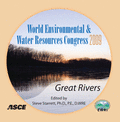An Innovative Approach for Modeling Large Urban Hydrologic Systems
Publication: World Environmental and Water Resources Congress 2009: Great Rivers
Abstract
The dynamics of the urban landscape are ever changing. As the population grows, urban sprawl gathers momentum and the path for a drop of rainfall changes complexion. The physical processes involved from when rain falls until when it reaches a treatment plant or waterway are highly non-linear. In larger urban catchments, these non-linearities have largely been ignored and linearized through development of lumped or semi-distributed models. This linearization is often used to overcome the sheer size and complexity of the urban catchments. The answer to the question of how much network complexity should be included in a model has been pre-empted by the application of conduit skeletonization and subcatchment aggregation. These simplification techniques are not without their dangers and may introduce bias into the predicted hydrographs. This paper provides a review of modeling approaches that are typically undertaken in modeling large urban catchments, highlighting their advantages and disadvantages. The majority of the approaches involve the application of hydrologic models that require calibration and significant knowledge of hydrologic inputs. In many cases the assessment of existing urban hydrologic systems is hindered by the absence of input data and/or calibration data. With this in mind, an innovative approach to modeling large urban hydrologic systems is presented. This approach builds on the fundamentals of the geomorphologic instantaneous unit hydrograph (GIUH) that was developed by Rodriguez-Iturbe and Valdes in 1979, which has been successfully applied to natural watersheds over the past three decades. Application of GIUH has evolved such that it can be applied to ungauged natural watersheds with knowledge of as little as the watershed area and layout of the stream network. The approach proposed in this research, in a similar manner, uses the morphology of the sewer system to route flow through the network. Excess rainfall is determined using the Green and Ampt method based on the physical characteristics of the underlying soils. The kinematic wave approach is used, in conjunction with stochastically generated parameters describing relevant subcatchment and sewer characteristics to establish probability distribution functions (PDF) for overland (both pervious and impervious) and sewer travel times. The PDF's of the travel time and excess rainfall are convoluted to generate an outflow hydrograph. This approach maintains the non-linearity of the physical processes in highly urbanized catchments and allows model development in the absence of detailed input and calibration data. Through application of this approach an improved understanding of the physical process can be achieved.
Get full access to this article
View all available purchase options and get full access to this chapter.
Information & Authors
Information
Published In
Copyright
© 2009 American Society of Civil Engineers.
History
Published online: Apr 26, 2012
ASCE Technical Topics:
- Bodies of water (by type)
- Business management
- Catchments
- Climates
- Engineering fundamentals
- Environmental engineering
- Hydrographs
- Hydrologic engineering
- Hydrologic models
- Hydrology
- Infrastructure
- Innovation
- Meteorology
- Models (by type)
- Practice and Profession
- Precipitation
- Rainfall
- River engineering
- River systems
- Urban and regional development
- Urban areas
- Water and water resources
- Water management
- Watersheds
Authors
Metrics & Citations
Metrics
Citations
Download citation
If you have the appropriate software installed, you can download article citation data to the citation manager of your choice. Simply select your manager software from the list below and click Download.
